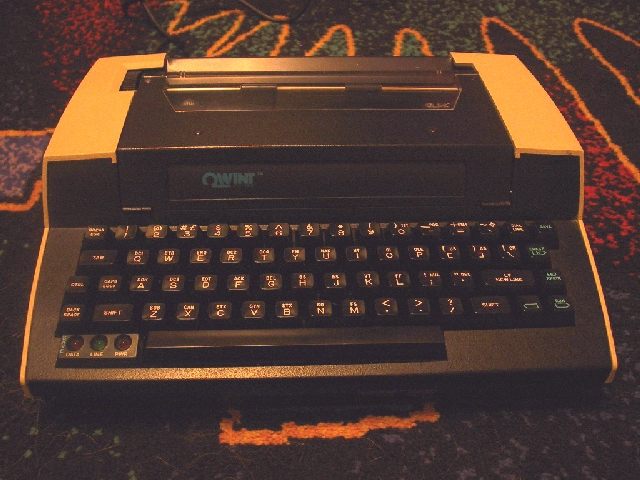
QWINT Teleprinter!

This is a Qwint MSR-744-16B teleprinter, made in 1984. I worked for this company in 1983-1984, and wrote the service manual for the line of teleprinters as well as parts of many of the operation guides and programmer's references. The design was ingenious, using an internal switching power supply (daring for the early 1980's) and, as small as it was, it printed on plain paper and could make several copies on carbonless forms. This gave it ownership of several niche markets where this was an absolute requirement. Compare this to the TI teleprinters of that era-and then consider that Qwint's financial resources could not have been 1/1000th of TI's then. They did amazing things with virtually nothing, and learning how to do this is the most important thing that I learned from working there. Qwint built cost-effective products not because it was a good idea - it was because they HAD to. The patented printhead, certainly a precision component, was assembled with hand tools, a press, and glue. The print frame assembly was entirely made of sheet metal and a few precision rods, built with hand tools, and requiring minimal adjustment.
Qwint Systems was formerly Martin Research, of "Microcomputer Design" fame - a seminal book considered to be many to the THE finest book on early microcomputer design, and a book that is to this day held up as a shining example of a clear description of a very technical subject. That out-of-print book is STILL in demand, although everything it describes is obsolete. I used this book to develop my 8008 computers.
Sadly, Qwint had developed the equivalent of the finest "buggy whip" ever built at the dawn of the automotive age - that is, the era of dial up mainframes was ending and the PC era was beginning. With the teleprinter market drying up, Qwint's assets were acquired by Zebra Technologies, the bar code printer manufacturer, in about 1986.
The teleprinters were very logically designated as follows (even 20 years later, it was fairly easy to remember)
XX-7YZ
Where XX was
RO=Read only, no keyboard (a blanking plate supplied)
KSR=Keyboard Send Receive
MSR=Memory send Receive (up to 16K of RAM, battery backed designated by -B at the end of the model name)
The Y could be
4=30 CPS series
8=120CPS series
and the Z was:
3=Current Loop or RS-232 only
4=Current Loop,RS-232, or internal modem (300 baud on the 740 series; 300/1200 on the 780 series)
5=Current Loop,RS-232, or internal modem (300 baud on the 740 series; 300/1200 on the 780 series), with acoustic coupler and carry case
The unit has some amazing technology; for example, an ingenious motor control circuit (patented) using back EMF to count dropped steps for compensation, allowing inexpensive stepper motors to achieve high speeds with no expensive encoders and a little software assistance. Motion control engineers danced around this patent for years. The firmware developers were Gods of Z-80 assembler (I do not say this lightly, having acheived some capability later in my career), and had developed a spectacular library of macros. I doubt if there are 1000 people in the world today as good in assembler - any assembler - as they were. The could write error-free code as fast as they could type, and that was very fast in most cases. The Z-80 of the Qwint teleprinter used bank switching to address more than 64K! The internal operating system was interrupt/time slice/preemptive multitasking, and very, very sophisticated for its time with hardware that was very low-end (read inexpensive to manufacture) even then.
The acoustic coupler operated on a 780-series machine was capable of operating at 1200 baud, even over long distance phone lines. To the best of my knowledge, no other company ever made an acoustic coupler of this speed. This was amazing; the only catch was that both ends of the conversation had to be MNP (Microcom Networking Protocol) capable. Many modems were capable of MNP at that time, so this was not a problem.
I acquired this unit, cleaned it up, reinked the (reinking) ribbon, replaced the 20-year old lithium battery and
ran it - it worked, but only for a few minutes. The good news was I still had the service manual, which I wrote;
the bad news was that I was missing the pages that I needed! Fortunately, I shotgunned the caps and switching transistor,
during which time I noticed a 22K resistor that was open (oddly, the resistors designed to be fuses - fusistors
- were all ok). With new caps and a new transistor with fresh heat sink grease, it works fine; I hope I've got
it "restored" for some time. The WAROM - a very early flash-like type of persistent RAM - was fine. I
remembered that it was notorious for failure, particaularly those from one supplier (not the one who made the one
I have, fortunately). The keyboard, using double-shot molded keys, has a feel that no PC keyboard made today at
any price can approach.
This will be a great companion for my PDP-8 clones.
Yes, I plan (SOON!!) to back up the 20-year old EPROMS shortly and put them on compact disk!